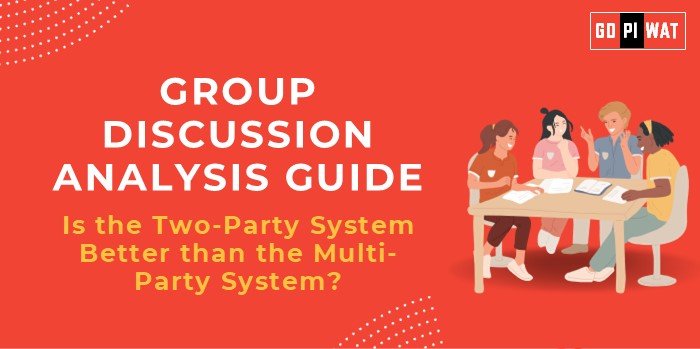📋 Group Discussion Analysis Guide: Is the Two-Party System Better than the Multi-Party System?
🌐 Introduction to the Topic
- 📖 Contextualization: The debate on two-party versus multi-party systems has profound implications for governance, political stability, and citizen representation worldwide. While nations like the United States thrive under a two-party system, countries such as India leverage the diversity of a multi-party framework.
- 🌍 Topic Background: The two-party system centralizes political power around two dominant parties, potentially offering clarity and stability. Conversely, multi-party systems, prevalent in democracies like India and Germany, allow for broader representation but may lead to coalition-driven instability. Recent global trends show increasing polarization in both systems.
📊 Quick Facts and Key Statistics
- 🇺🇸 United States (Two-Party): Consistent voter turnout around 55%-60% (2020 elections).
- 🇮🇳 India (Multi-Party): Largest democracy with over 2,500 registered parties; 67% voter turnout in 2019 Lok Sabha elections.
- 🌍 Global Spectrum: 70% of democracies function under multi-party systems.
- ⚖️ Coalition Challenges: Italy has witnessed 69 governments since 1945 due to coalition instability.
- 📉 Two-Party System Drawbacks: Pew Research (2023) reports 60% of Americans feel unrepresented by two main parties.
🤝 Stakeholders and Their Roles
- 👥 Citizens: Influence governance by casting votes and engaging in advocacy.
- 🏛️ Political Parties: Formulate policies, represent ideologies, and shape governance structures.
- ⚖️ Government Institutions: Ensure smooth functioning regardless of the political system.
- 🌍 Global Organizations: Promote democratic practices and provide comparative governance models.
🏆 Achievements and Challenges
✨ Achievements:
Two-Party System:
- ✅ Stable Governance: Avoids fractured mandates.
- 📊 Electoral Simplicity: Simplifies decisions for voters.
- ⚖️ Reduced Legislative Deadlock: Minimizes coalition disagreements.
Multi-Party System:
- 🌟 Enhanced Representation: Captures diverse communities and viewpoints.
- 🤝 Promotes Negotiation: Encourages coalition-building, fostering compromise.
- ⚖️ Prevents Dominance: Reduces risks of single-party control.
⚠️ Challenges:
Two-Party System:
- 📉 Limited Choice: Increases voter disenfranchisement.
- ⚠️ Ideological Polarization: Stifles bipartisan collaboration.
Multi-Party System:
- 📉 Coalition Instability: Frequent elections due to fractured mandates.
- ⚖️ Minority Influence: Small groups may exert disproportionate power.
🌍 Global Comparisons:
- 🇬🇧 Two-Party Success: United Kingdom’s alternating governance by Labour and Conservatives.
- 🇩🇪 Multi-Party Success: Germany balances stability and representation with coalition governance.
- 🇺🇸 Two-Party Failure: US government shutdowns over budget deadlocks.
- 🇮🇱 Multi-Party Failure: Israel faced five elections in four years due to coalition instability.
💡 Structured Arguments for Discussion
- 📢 Supporting the Two-Party System: “The two-party system offers a clear and stable governance framework, ensuring policy continuity and preventing the risks of fractured mandates seen in multi-party systems.”
- ❌ Opposing the Two-Party System: “The multi-party system provides a voice to diverse populations and fosters inclusive governance, addressing needs that a binary system may overlook.”
- ⚖️ Balanced Perspective: “Each system has merits and limitations; the suitability often depends on a country’s socio-political fabric and historical context.”
📌 Effective Discussion Approaches
🎯 Opening Approaches:
- 📊 Comparative Statistic: “While over 70% of democracies operate under a multi-party system, some of the most stable ones like the US and UK use a two-party framework.”
- 📋 Case Study: “India’s multi-party system reflects its cultural diversity, but frequent coalition collapses highlight its challenges.”
- 💡 Philosophical Lens: “The essence of democracy lies in representation—how effectively do the two systems serve this goal?”
🔄 Counter-Argument Handling:
- 🌍 Use global examples to challenge assumptions (e.g., Italy for instability, Germany for success).
- 📋 Reframe the discussion by focusing on socio-economic outcomes.
📚 Strategic Analysis of Strengths and Weaknesses
- 💪 Strengths:
- ⚖️ Two-Party: Stability, clarity in policy direction.
- 🌟 Multi-Party: Representation, inclusivity.
- ❌ Weaknesses:
- 📉 Two-Party: Polarization, voter dissatisfaction.
- ⚖️ Multi-Party: Instability, slower decision-making.
- ✨ Opportunities:
- 📋 Two-Party: Promoting centrist policies through reforms.
- 🤝 Multi-Party: Leveraging coalitions for inclusive growth.
- ⚠️ Threats:
- 📢 Two-Party: Risks of dominance by a single ideology.
- ⚖️ Multi-Party: Governance paralysis in divided legislatures.
🎓 Connecting with B-School Applications
🌐 Real-World Applications:
- 📋 Policy analysis and stakeholder negotiation in coalition setups.
- 🌟 Leadership challenges in diverse or polarized environments.
❓ Sample Interview Questions:
- ❓ “Can coalition governance models improve decision-making in organizations?”
- 💡 “How can leaders manage polarization in competitive environments?”
📈 Insights for Students:
- 📖 Study comparative political systems to understand stakeholder dynamics.
- 🤝 Draw lessons from coalition building for teamwork and resource management.


